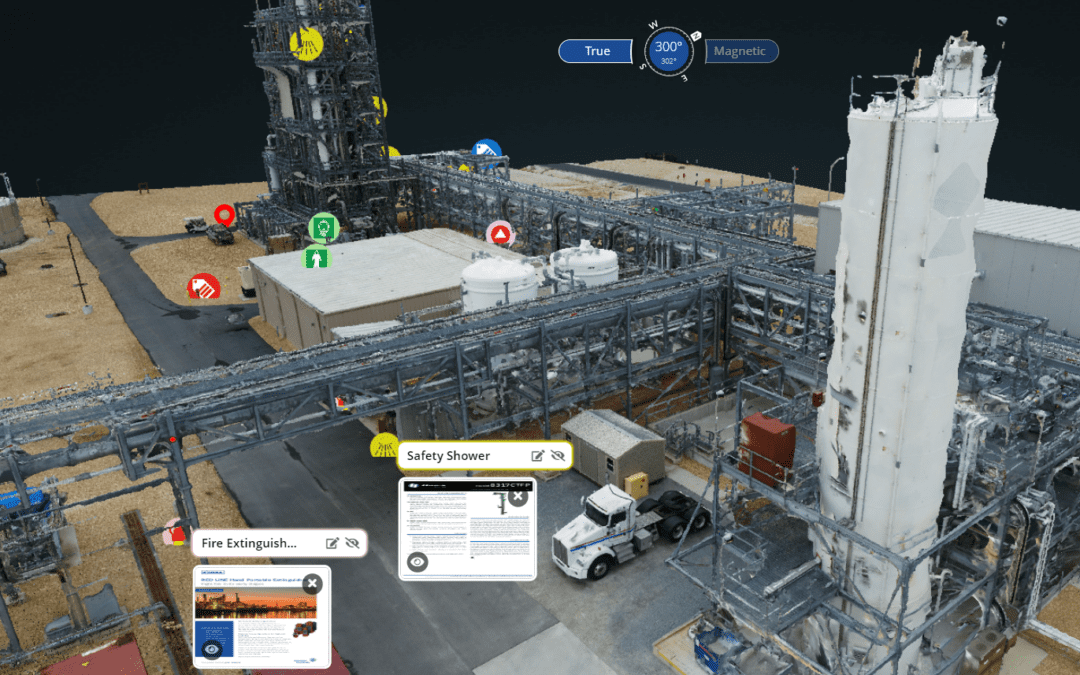The powerful combination of drone data collection, digital twin reality models, and visual data management can upgrade site safety asset planning and accident investigations
Using the Optelos Safety Asset Planning Module capabilities with digital twins, facilities can more effectively manage the placement and oversight of safety equipment, create turnaround safety plans, investigate incidents, and more easily and effectively present safety data to leadership and employees.
Each year, tens of thousands of workers are injured—or worse—in accidents related to normal operations in industrial facilities. Research shows industrial sites are prone to incidents like slips/trips/falls; struck by dropped objects; electrocution; contact with equipment; and more. A 2023 report identified hundreds of potential hazardous chemical incidents, such as leaks & spills, just in the past three years. In extreme cases—like a chain of explosions at one Texas refinery—people can lose their lives.
Fortunately, recent technology developments put gains in safety improvements and risk reduction within reach. The power of drone inspection services, digital twin reality models, and visual data management combined with existing safety programs can enhance site safety and reduce risks to personnel through geolocation of safety-related assets in a digital twin model, enabling visualization of critical safety asset and incident response data.

Safety incident investigations and trend analyses are aided by being able to plot the location of incidents on the digital twin with all relevant data, including incident reports, root cause analyses, observation cards and other management tools.
Optelos makes it easy to annotate and include specific safety-related icons, notations, and documents to the digital model. That gives users a far more comprehensive, accessible, and visually understandable view of site safety assets & incidents. Users can then manipulate the models (e.g., rotating the models 360 degrees to verify both horizontal and vertical placement and distance from key equipment using Optelos’ embedded measurement tools) for further safety analysis, planning, and risk mitigation/prevention.
Optelos in Action: The Impact of Visualizing and Contextualizing Safety Assets and Incidents
Optelos offers an unparalleled window into site safety through a comprehensive, single-source, high-level “bird’s eye view” of all safety information, an invaluable tool for site safety managers, facility leadership, and all personnel working on site. The Optelos Digital Twin works as a data repository that can be enhanced with safety data via links and annotations to provide a contextual view of the physical asset.
Users can easily place custom icons on the Optelos Digital Twin to document the asset’s location and safety-related information at a glance. Asset or incident-specific information can include custom annotations related to potential hazards; geolocating & contextualizing – permanent, temporary, and project-related safety assets; documentation like user manuals and safety equipment inspection reports; and managing any other information related to safety investigations, audits, and reports; and more.
Optelos consolidates the full scope of safety-related data within a single source of truth: the digital twin. A complete 3D replica of an entire facility or jobsite, the digital twin can be thoroughly annotated to capture and visually present all relevant safety information in the context of where it appears in or around a site.

There are many applications for utilizing digital twins to improve the oversight and management of job site safety assets and incident investigations.
Reduce the number and severity of safety incidents
The more comprehensive and easier-to-view model makes it possible to see how all safety plans and resources fit together visually from a strategic perspective. Optelos thus enables planners to verify that safety resource utilization is well-planned, e.g., noticing that they have a specific fire risk in one area, planners can evaluate if placement of fire response apparatus is logistically accessible, before they face a serious incident in the field. Similarly, the planners can also visualize and simulate various workflows by operating area to ensure their safety plans are viable in the field. They can do this all of this on a remote basis, without needing to set foot within the operating units. The result: fewer incidents and more effective responses to those that do occur.
Improve and speed up safety reviews, planning, and investigations
After an event, safety managers can use the Optelos Safety Planning Module and 3D Reality Models to quickly visualize & contextualize all aspects of the incident’s location & surrounding environments.
Having the ability to geolocate & map incidents greatly increases the visibility for the individuals conducting the post incident investigation & reporting workflows. Investigators can effectively recreate the chain of events in the visual model to understand, step-by-step, the root cause of the incident. Post investigation, all aspects of the root cause analysis and associated discovery can then be documented; on a visual & contextualized basis, within the digital twin, exactly where the incident occurred.
Safety Teams & Project Planners can then analyze and use the “visualized lessons learned” identified and layered within the reality models over the course of time to fine tune existing & future workflows/work locations in an effort to mitigate risks and to maximize worker safety.

Noting the location of all safety equipment on a 3D model with appended key documentation provides easy and intuitive access to key safety asset information.
The fundamental goal of the Optelos Safety Asset Planning Module is to assist in the avoidance of safety related incidents and the associated injuries & costs to all stakeholders. We accomplish this through the visualization & contextualization of all safety assets, safety & emergency response planning, and incident investigation & reporting. All told, the Optelos Safety Asset Planning Module enhances project safety plans and increases the awareness of the inherent risks associated with in-scope workflows and can be a valuable tool in enhancing the execution of your team’s safety programs.
